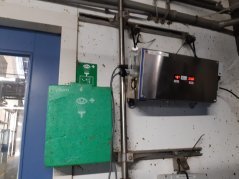
category_news
Sniffer measures methane and carbon dioxide concentration on Dairy Campus
Since the beginning of October, a "sniffer" has been hanging on the wall of the milking robot on Dairy Campus. This device measures the methane and carbon dioxide concentration in the air that the cows exhale during each milking. These measurements are part of the project "Genetic possibilities to reduce enteric methane emissions from dairy cattle" and will take place at 18 dairy farms in the Netherlands in the coming period.

On Dairy Campus, the "sniffer" is now mounted close to the milking robot. In the coming period, this device will collect data that will contribute to charting the differences in methane emissions between animals and the heritability thereof in cattle. In addition to the sniffer, the green feed will also be used to collect the data. The sniffer only measures the concentration of methane and carbon dioxide in the breathing air, while the greenfeed can display the total amount of methane (emission). In the feeding shed on Dairy Campus, there is a green feed that will record methane emissions within this research in the coming period.
The differences from the measurement data are linked to the genetic characteristics of the animals. The cows are genotyped in advance. For example, the concentration data from the sniffer will be combined with visit data from the milking robot. This produces a lot of data in a short time. The total dataset contributes to new insights in breeding and the emission of methane. This research ensures:
- Comparison of the ranking of the cows based on the measurement results of the Sniffer and Greenfeed measurement method
- Overview of differences in methane emissions between individual animals
- Determining the heritability of methane emissions (methane emissions in 2500 animals)
- The first estimate of genetic correlations with other important breeding traits
- Compare methane emissions from various varieties (Jersey, Blaarkop, Brown Swiss, Holsteins).
The research is funded by the Ministry of Agriculture, Nature and Food Quality and is part of the so-called Methane Climate Envelope 2019. In the context of the Climate Agreement, the Ministry of Agriculture, Nature and Food Quality is working, in coordination with sector organizations, on reducing greenhouse gases in dairy farming.
